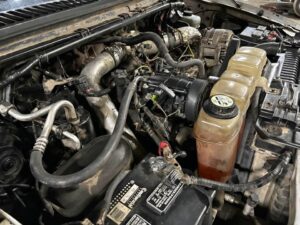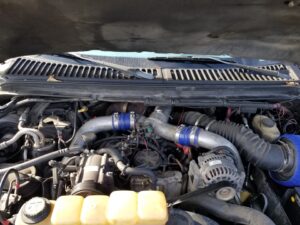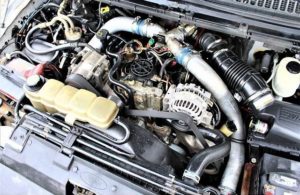Welcome to 73PSD.com!

The starting point for finding specs, manuals, information, and an aggregation of links to resources for the Ford 7.3L Power Stroke Diesel Engine.
Check out our Manuals Page for PDF’s and Links to Service Information.
Many diesel engines have their fans but the 7.3L Power Stroke Diesel has a following and has continued to hold its beloved status to current day, decades after being discontinued. Daily users still testify to the 7.3 due to its reliability and self serviceability. Produced from 1994.5 to 2003, the 7.3L PSD was introduced the most powerful in its class built on cutting edge injector technology. Now seen as a dinosaur and a relic from the past by modern diesel engine standards, the 7.3L PSD continues to prove that it can still get the job done without breaking the bank and without breaking down. 7.3 powered OBS and PS Ford trucks are still a highly sought after choice for those looking to save money or perform service, repairs, and maintenance themselves when choosing a used diesel powered vehicle.
A little history:
The Ford Power Stroke engine family was born in 1994. At the time Navistar International Corp had been Ford’s contracted diesel engine supplier since 1983 producing diesel engines for Ford’s heavy duty truck lineup. There were multiple versions of the 7.3 engine provided by Navistar. In more recent times Ford decided to sever the relationship with Navistar. Simply put contract issues and shortfalls with the 6.0 and 6.4 diesel engines led to an early termination of the Ford and Navistar agreement after nearly 30 years of partnership. The Power Stroke replaced the previous 7.3L IDI engine which also has a loyal following, but is not the focus of this website. Ford Engineer’s teamed up with Navistar to create the 7.3L Power Stroke engine based off the Industrial/Commercial grade T444E (Turbo charged 444 cubic inch Electronically Controlled) engine that had a B50 Life rating of 350,000 miles that Navistar used in International vehicles up to 65,000lbs GVWR primarily being school buses but also dump trucks and box trucks. Ford took the T44E medium duty commercial engine and made it their own by adding their own proprietary programming driven by their own PCM (power train control module). They revamped how the engine operated from its original commercial use design to a be more favorable for pickup truck usage. Ford gave the engine higher revs, more power, and better transmission control. The PSD utilized a different turbo design, late models changed to an electronic fuel pump, and additional engine sensors were used resulting in what we now know as the Ford 7.3L Power Stroke. The result was an engine with Ford’s tech producing more horse power than any of the Navistar T444E options available from International at the time.
In terms of numbers, over 750,000 T444E engines went into Navistar’s International vehicles while Ford’s 7.3L Power Stroke went into around 2 million vehicles including trucks, vans, shuttle buses, and ambulances making it a huge success. Over time the engine became revered for having legendary reliability because with proper routine maintenance the engines were regularly surpassing their B50 life rating. Many 7.3L PSD vehicles easily rang in 400,000+ miles without any major issues. There are also noticeable numbers reported making it to the million mile club on the original engine. Despite using the latest and greatest injection technology at the time the 7.3L PSD turned out to be simple to work on which definitely helped it’s the favorable reputation of being one of the most sought after diesel engines ever produced.
Ford stuck the power stroke in all of their heavy duty models including the E and F series 250, 350, 450, and even 550 series vehicles. Many of these seeing fleet service in a multitude of industries. Due to changing times especially in the area if emissions standards the 7.3L PSD was replaced as Ford’s Diesel Engine with newer current emissions compliant engines. It wasn’t long after 2 engine changes in the PowerStroke line that the older 7.3L powered vehicles were noticed to have required less service and just kept going while newer emissions models were having issues causing noticeably increased maintenance downtime. You can still find plenty of 20+ year old 7.3L PSD vehicles being used regularly in the wild for both commercial and personal use. Checking the used truck market 7.3L PSD vehicles are still in high demand being bought and sold day in and day out helping to prove the desire people have for this engines history of reliability and longevity.
The desire for the 7.3L PSD isn’t to have the fastest or most powerful vehicle, but instead to have a reliable work horse without modern emissions setups known to have issues that is self serviceable and that gets the job done day in and day out without breaking the bank. A true work horse.


